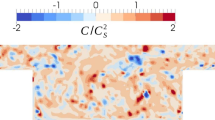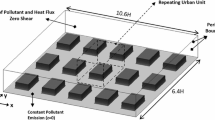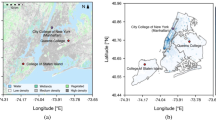Abstract
The mean and random components of the velocity field at very low wind speeds in a convective boundary layer (CBL) over a wide urban area are dominated by large eddy structures—either turbulent plumes or puffs. In the mixed layer at either side of the edges of urban areas, local mean recirculating flows are generated by sharp horizontal temperature gradients. These recirculation regions also control the mean shear profile and the bent-over plumes across the mixed layer, extending from the edge to the center of the urban area. A simplified physical model was proposed to calculate the mean flow speed at the edges of urban areas. Water tank experiments were carried out to study the mean recirculating flow and turbulent plume structures. The mean speed at urban edges was measured by the particle image velocimetry (PIV), and the plume structures were visualized by the thermalchromic liquid crystal (TLC) sheets. The horizontal velocity calculated by the physical model at the urban edge agrees well with that measured in the water tank experiments, with a root mean square of 0.03. The experiments also show that the pattern of the mean flow over the urban area changes significantly if the shape of the heated area changes or if the form of the heated urban area becomes sub-divided, for example by the creation of nearby but separated “satellite cities.” The convective flow over the square urban area is characterized as the diagonal inflow at the lower level and the side outflow at the upper level. The outflow of the small city can be drawn into the inflow region of the large city in the “satellite city” case. A conceptual analysis shows how these changes significantly affect the patterns of dispersion of pollutants in different types of urban areas.














Similar content being viewed by others
References
Carruthers DJ, Moeng C-H (1987) Waves in the overlying inversion of the convective boundary layer. J Atmos Sci 44:1801–1808
Catalano F, Cenedese A, Falasca S, Moroni M (2012) Numerical and experimental simulations of local winds. In: Fernando HJS et al. (eds) National Security and human health implications of climate change. pp 199–218
Cenedese A, Monti P (2003) Interaction between an inland urban heat island and a sea-breeze flow: a laboratory study. J Appl Meteorol 42:1569–1583
Coelho SLV, Hunt JCR (1989) Vorticity dynamics of the near field of strong jets in cross flows. J Fluid Mech 200:95–120
Colomer J, Boubnov B, Fernando HJS (1999) Turbulent convection from isolated sources. Dynam Atmos Oceans 30:125–148
Deardorff JW (1970) Convective velocity and temperature scales for the unstable planetary boundary layer and for Rayleigh convection. J Atmos Sci 27:1211–1213
Fan Y, Hunt JCR, Li Y (2017) Buoyancy and turbulence-driven atmospheric circulation over urban areas. J Environ Sci 59:63–71
Faust K (1981) Modelldarstellung von Wärmeinselströmungen durch konvektionsstrahlen. Ph.D. thesis. Universität Karlsruhe, 144pp
Gaubatz P (1999) China’s urban transformation: patterns and processes of morphological change in Beijing, Shanghai and Guangzhou. Urban Stud 36:1495–1521
Hidalgo J, Masson V, Gimeno L (2010) Scaling the daytime urban heat island and urban-breeze circulation. J Appl Meteor Climatol 49:889–901
Hunt JCR (1998) Eddy dynamics and kinematics of convective turbulence, buoyant convection in geophysical flows. In: Plate EJ, Fedorovich EE, Viegas DX, Wyngaard JC (eds) Buoyant Convection in Geophysical Flows. Kluwer, Dordrecht, pp 41–82
Hunt JCR, Abell CJ, Peterka JA, Woo HGC (1978) Kinematical studies of the flows around free or surface-mounted obstacles: applying topology to flow visualization. J Fluid Mech 86:179–200
Hunt JCR, Vrieling AJ, Nieuwstadt FTM, Fernando HJS (2003) The influence of the thermal diffusivity of the lower boundary on eddy motion in convection. J Fluid Mech 491:183–205
Hunt JCR, Bohnenstengel S, Belcher SE, Timoshkina Y (2013) Implications of climate change for expanding cities world-wide. Proc ICE-Urban Des Plann 166:241–254
Hunt JCR, Moustaoui M, Mahalov A (2015) The eddy, wave, and interface structure of turbulent shear layers below/above stably stratified regions. J Geophys Res-Atmos 120:9237–9257
Hunt JCR, Chan JCL, Wu J (2016) Asian urban environment and climate change. Curr Sci India 110:1398–1400
Kristof G, Rácz N, Balogh M (2009) Adaptation of pressure based CFD solvers for mesoscale atmospheric problems. Bound-Layer Meteorol 131:85–103
Kurbatskii AF (2001) Computational modeling of the turbulent penetrative convection above the urban heat island in a stably stratified environment. J Appl Meteorol 40:1748–1761
Launder BE, Rodi W (1983) The turbulent wall jet measurements and modelling. Ann Rev Fluid Mech 15:429–459
Li X, Zhang L, Liang C (2010) A GIS-based buffer gradient analysis on spatiotemporal dynamics of urban expansion in Shanghai and its major satellite cities. Procedia Environ Sci 2:1139–1156
Lu J, Arya SP, Snyder WH, Lawson RE Jr (1997) A laboratory study of the urban heat island in a calm and stably stratified environment. Part II: velocity field. J Appl Meteorol 36:1392–1402
Min Y, Lee M, Kim D, Heo J (2013) Annual and seasonal variations in atmospheric PCDDs/PCDFs and dioxin-like PCBs levels in satellite cities of Seoul, Korea during 2003-2009. Atmos Environ 77:222–230
Morton B, Taylor G, Turner J (1956) Turbulent gravitational convection from maintained and instantaneous sources. Proc R Soc Lon Ser-A 234:1–23
Ohashi Y, Kida H (2002) Local circulations developed in the vicinity of both coastal and inland urban areas: a numerical study with a mesoscale atmospheric model. J Appl Meteorol 41:30–45
Oke TR (1995) The heat island of the urban boundary layer: characteristics, causes and effects. In: Cermak JE, Davenport AG, Plate EJ, Viegas DX (eds) Wind climate in cities. Springer, Netherlands, pp 81–107
Plate EJ, Fedorovich EE, Viegas DX, Wyngaard JC (1998) Buoyant convection in geophysical flows. Springer Science and Business Media, Germany 491 pp
Prasad AK, Adrian RJ, Landreth CC, Offutt PW (1992) Effect of resolution on the speed and accuracy of particle image velocimetry interrogation. Exp Fluids 13:105–116
Priestley CHB (1959) Turbulent transfer in the lower atmosphere. University of Chicago Press, Chicago, p 130
Puttock JS, Hunt JCR (1979) Turbulent diffusion from sources near obstacles with separated wakes. Part I. An eddy diffusivity model. Atmos Environ 13:1–13
Ramachandran S, Wyngaard JC (2014) An a priori study of the subfilter-scale conservation equations for the stably stratified atmospheric surface layer. Q J Roy Meteor Soc 140:1304–1314
Richiardone R, Brusasca G (1989) Numerical experiments on urban heat island intensity. Q J Roy Meteor Soc 115:983–995
Scorer RS (1978) Environmental aerodynamics. Halsted Press, Chichester 488 pp
Shi Z, Shao L, Jones TP, Whittaker AG, Lu S, Berube KA, He T, Richards RJ (2003) Characterization of airborne individual particles collected in an urban area, a satellite city and a clean air area in Beijing, 2001. Atmos Environ 37:4097–4108
Townsend AA (1976) The structure of turbulent shear flow. Cambridge University Press, New York, p 433
Van Reeuwijk M, Jonker HJJ, Hanjalic K (2008) Wind and boundary layers in Rayleigh-Bénard convection. I. Analysis and modelling. Phys Rev E 77:03611
Wang W (2009) The influence of thermally-induced mesoscale circulations on turbulence statistics over an idealized urban area under a zero background wind. Bound-Layer Meteorol 131:403–423
Willert CE, Gharib M (1991) Digital particle image velocimetry. Exp Fluids 10:181–193
Yoshikado H (1992) Numerical study of the daytime urban effect and its interaction with the sea breeze. J Appl Meteorol 31:1146–1164
Zilitinkevich SS, Hunt JCR, Esau IN, Grachev AA, Lalas DP, Akylas E, Tombrou M, Fairall CW, Fernando HJS, Baklanov AA, Joffre SM (2006) The influence of large convective eddies on the surface-layer turbulence. Q J Roy Meteor Soc 132:1426–1456
Acknowledgements
This project was supported by funding from the Collaborative Research Fund of Hong Kong’s Research Grants Council (Grant No. HKU9/CRF/12G). Julian Hunt acknowledges support from ANCST, the British Council, and RCUK.
Author information
Authors and Affiliations
Corresponding author
Electronic supplementary material
ESM 1
(DOCX 1.74 mb)
Rights and permissions
About this article
Cite this article
Fan, Y., Hunt, J., Yin, S. et al. Mean shear flow in recirculating turbulent urban convection and the plume-puff eddy structure below stably stratified inversion layers. Theor Appl Climatol 135, 1485–1499 (2019). https://doi.org/10.1007/s00704-018-2458-9
Received:
Accepted:
Published:
Issue Date:
DOI: https://doi.org/10.1007/s00704-018-2458-9




